
The Staatliches Bauhaus, commonly known as the Bauhaus, was a German art school operational from 1919 to 1933 that combined crafts and the fine arts. The school became famous for its approach to design, which attempted to unify the principles of mass production with individual artistic vision and strove to combine aesthetics with everyday function.
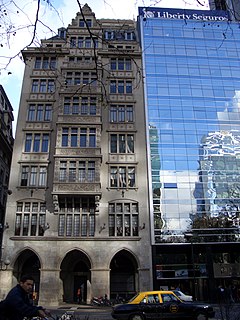
Bunge & Born was a multinational corporation based in Buenos Aires, Argentina, whose diverse interests included food processing and international trade in grains and oilseeds. It is now known as Bunge Limited.
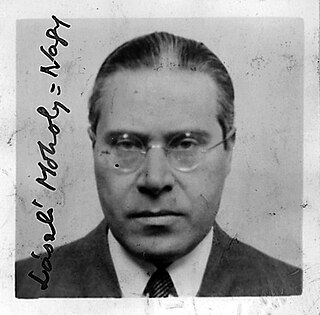
László Moholy-Nagy was a Hungarian painter and photographer as well as a professor in the Bauhaus school. He was highly influenced by constructivism and a strong advocate of the integration of technology and industry into the arts. The art critic Peter Schjeldahl called him "relentlessly experimental" because of his pioneering work in painting, drawing, photography, collage, sculpture, film, theater, and writing.

The Architectural Review is a monthly international architectural magazine. It has been published in London since 1896. Its articles cover the built environment – which includes landscape, building design, interior design and urbanism – as well as theory of these subjects.

The Moholy-Nagy University of Art and Design, former Hungarian University of Arts and Design, is located in Budapest, Hungary. Named after László Moholy-Nagy, the university offers programs in art, architecture, designer and visual communication.
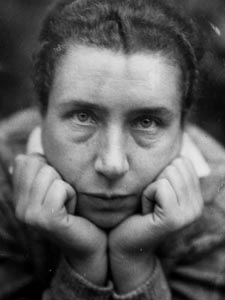
Lucia Moholy, born Lucia Schulz, was a photographer and publications editor. Her photos documented the architecture and products of the Bauhaus, and introduced their ideas to a post-World War II audience. However Moholy was seldom credited for her work, which was often attributed to her husband László Moholy-Nagy or to Walter Gropius.
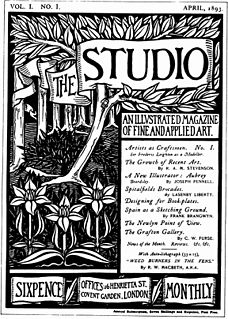
The Studio: An Illustrated Magazine of Fine and Applied Art was an illustrated fine arts and decorative arts magazine published in London from 1893 until 1964. The founder and first editor was Charles Holme. The magazine exerted a major influence on the development of the Art Nouveau and Arts and Crafts movements. It was absorbed into Studio International magazine in 1964.
Frans Wildenhain was a Bauhaus-trained German potter and sculptor, who taught for many years at the School for American Craftsmen at the Rochester Institute of Technology in Rochester, NY.
A luminogram is an image, usually made with an artistic purpose, created by exposure of photosensitive materials to light without the intervention of an object,
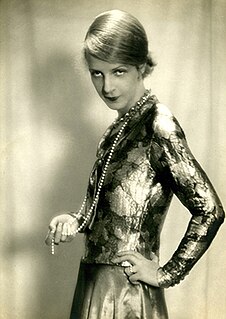
Sibyl Moholy-Nagy was an architectural and art historian. Originally a German citizen, she accompanied her second husband, the Hungarian Bauhaus artist László Moholy-Nagy, in his move to the United States. She was the author of a study of his work, Moholy-Nagy: Experiment in Totality, plus several other books on architectural history.

Global Sources Magazines are a series of trade magazines designed for businesses importing from China and Asia. There are 19 specialized industry-specific titles published by the business-to-business media company Global Sources. All except two titles are published monthly.
Elsbeth Ruth Juda, née Goldstein and known professionally as Jay, was a British photographer most notable for her pioneering fashion photographs and work as associate editor and photographer for The Ambassador magazine between 1940 and 1965.

The International Federation of Trade Unions was an international organization of trade unions, existing between 1919 and 1945. IFTU had its roots in the pre-war IFTU.

DAKS is a British luxury fashion house, founded in 1894 by Simeon Simpson in London. The name is a combination of the initials of Alexander Simpson and an initial and final letter of his business associate Dudley Beck.

The Republic of Texas was a North American nation from 1836 to 1845; in its short time it established diplomatical relations worldwide, mainly through the cotton trade.

Vivienne Balla is a Hungarian fine art and fashion photographer. She holds a master's degree in Photography. The Hungarian Fashion & Beauty Photographer graduated in Moholy-Nagy University of Art and Design, in 2010. Her photos have been published in world-renowned magazines and has received a number of accolades. Vivienne's specialty is Fashion, Beauty, Advertising and Portrait photography. In 2014 she moved to Dubai to start her international career. In the same year she got represented in Tokyo, Milan and Munich.

Éva Besnyő (1910–2003) was a Dutch-Hungarian photographer who participated in the Nieuwe Fotografie movement.

India–Netherlands relations refer to foreign relations between India and the Netherlands. India maintains an embassy in The Hague, Netherlands and the Netherlands maintains an embassy in New Delhi and a consulate general in Mumbai. Both countries established diplomatic relations in 1947.
The Bauhaus was seen as a progressive academic institution, as it declared equality between the sexes and accepted both male and female students into its programs. During a time when women were denied admittance to formal art academies, the Bauhaus provided them with an unprecedented level of opportunity for both education and artistic development, though generally only in weaving and other fields considered at the time to be appropriate for women.

Bangladesh–Netherlands relations refer to the bilateral relations between Bangladesh and Netherlands.














